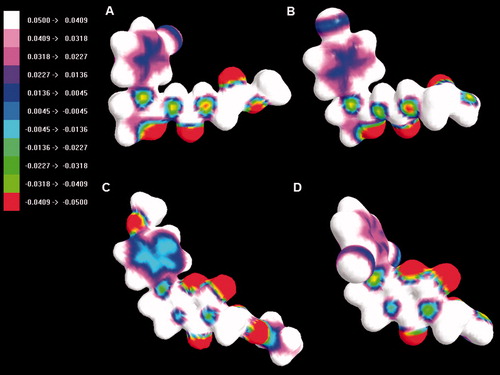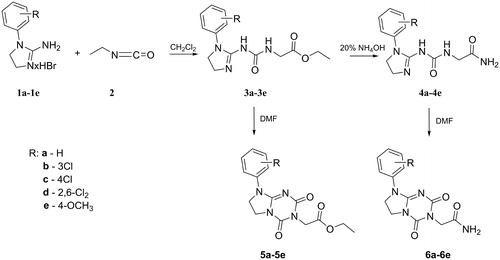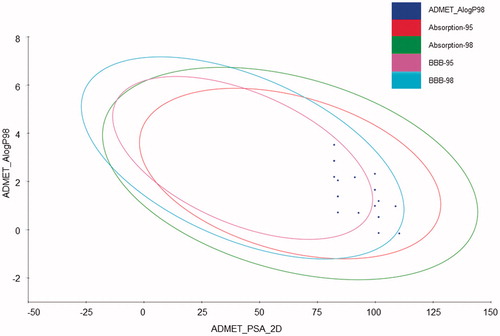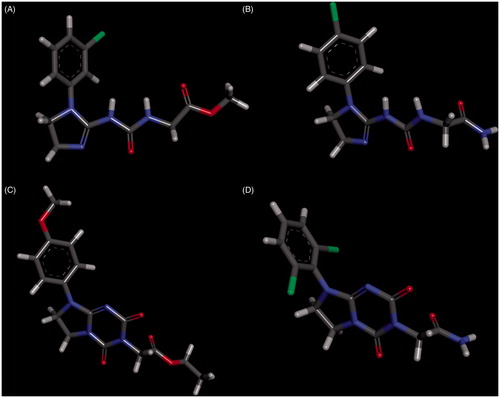Figures & data
Figure 1. Structural formulas of bezitramide, fentanyl and petidine. Pharmacophoric features according to the Beckett’s model are shown in boldCitation2,Citation12.

Figure 2. Non-classical opioid receptor pharmacophore models. B, base; Ar, aromatic; H, hydrophobic region; HA, hydrogen bond acceptorCitation2,Citation12.

Figure 3. Previously reported antinociceptive and serotoninergic compounds. Series A–E and partially F exert their antinociceptive activity through the opioid system. Series G and some of compounds from series F have antinociceptive activity of unknown mechanismCitation2,Citation8–12.
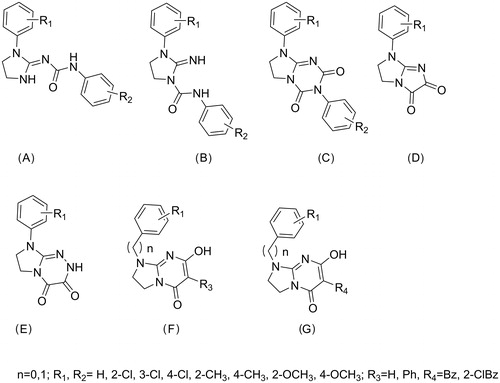
Figure 4. Pharmacophore model for the 5HT2 receptorCitation2,Citation10,Citation12.
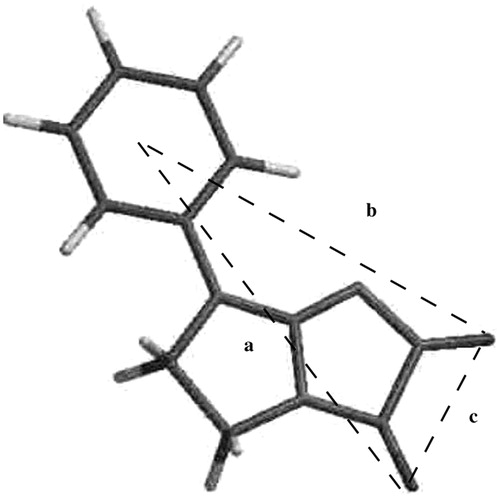
Table 1. Parameters for drug-likeness estimation.
Table 2. ADMET parameters of the studied compounds.
Table 3. The effect of the new compounds on the PTZ-induced clonic seizures, tonic convulsions and death of mice.
Figure 6. The influence of compounds from series 3 and 5 compounds on the spontaneous motor activity of mice. One-way ANOVA showed significant changes in locomotor activity of mice [F(11,87) = 4.657; p < 0.0001]. The post-hoc Dunnett’s test confirmed a significant reduction in motility of mice after the administration of series 3 compounds at the dose of 0.1 ED50: (3b) (p < 0.01), and (3c, 3e) ED50 (p < 0.05) and series 5 compounds: (5a) at the dose of 0.1 ED50 (p < 0.001) and (5e) at the doses of 0.1 and 0.05 ED50 (p < 0.01).
![Figure 6. The influence of compounds from series 3 and 5 compounds on the spontaneous motor activity of mice. One-way ANOVA showed significant changes in locomotor activity of mice [F(11,87) = 4.657; p < 0.0001]. The post-hoc Dunnett’s test confirmed a significant reduction in motility of mice after the administration of series 3 compounds at the dose of 0.1 ED50: (3b) (p < 0.01), and (3c, 3e) ED50 (p < 0.05) and series 5 compounds: (5a) at the dose of 0.1 ED50 (p < 0.001) and (5e) at the doses of 0.1 and 0.05 ED50 (p < 0.01).](/cms/asset/5daeb542-e722-47d2-98b1-a05d9329a92e/ienz_a_965699_f0006_b.jpg)
Figure 7. The influence of compounds from series 3 and 5 on the nociceptive reactions studied in the acetic acid (0.6%)-induced writhing test. One-way ANOVA showed significant changes in the number of writhing episodes of mice (F(5,42) = 2.766, p < 0.05). Post-hoc Dunnett’s test confirmed a significant reduction in the writhing episodes of mice after the administration of compound 3b at the dose of 0.1 ED50 (p < 0.05) and compounds: 5a at the doses of 0.1 and 0.05 ED50 (p < 0.05) and 5e at the doses of 0.1 and 0.05 ED50 (p < 0.0 and p < 0.01, respectively).
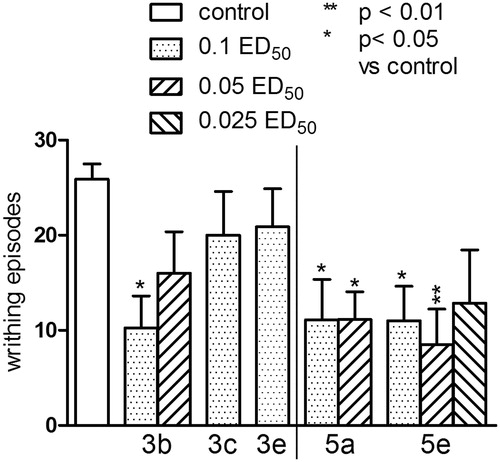
Figure 8. The influence of naloxone, 5 mg/kg, s.c. on antinociceptive activity of series 5 (compounds 5a and 5e), evaluated in the acetic acid (0.6%)-induced writhing test. One-way ANOVA showed significant changes in the number of writhing episodes of mice after the administration of compounds 5a and 5e and coadministration of these compounds with naloxone (F(4,31) = 4.073, p < 0.01). Post-hoc Dunnett’s test showed a significant reduction in the writhing episodes of mice after the administration of the compounds 5a and 5e at the dose of 0.1 ED50 (p < 0.05 and p < 0.001, respectively). Pretreatment with naloxone did not affect the numer of writhing episodes as compared to respective compounds tested.
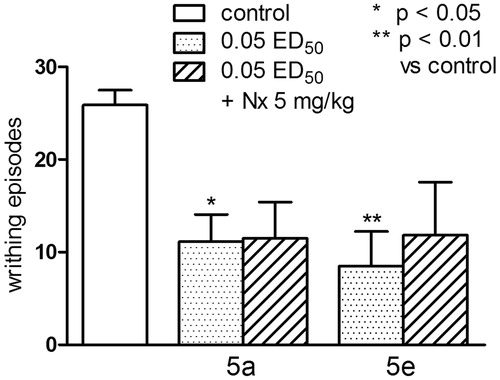
Figure 9. The influence of series 3 and 5 compounds on the head twitch responses (HTR) evoked by 5-hydroxy-L-tryptophan (L-5-HTP, 230 mg/kg). One-way ANOVA showed significant changes in the number of HTR [F(5,42) = 2.460; p < 0.05]. Post-hoc Dunnett’s test confirmed a significant reduction in HTR of mice after the administration of compound (3e) at the dose of 0.1 ED50 (p < 0.05).
![Figure 9. The influence of series 3 and 5 compounds on the head twitch responses (HTR) evoked by 5-hydroxy-L-tryptophan (L-5-HTP, 230 mg/kg). One-way ANOVA showed significant changes in the number of HTR [F(5,42) = 2.460; p < 0.05]. Post-hoc Dunnett’s test confirmed a significant reduction in HTR of mice after the administration of compound (3e) at the dose of 0.1 ED50 (p < 0.05).](/cms/asset/0607908e-be94-461e-b8a1-85bc8ed59e10/ienz_a_965699_f0009_b.jpg)
Figure 10. The influence of compounds 3c, 5a and 5e used at the doses of 0.1 and 0.05 ED50 on the body temperature of mice. Post-hoc Bonferroni test confirmed a significant decrease in the body temperature of mice after the administration of compound 5a at the dose of 0.1 ED50 from 30 to 120 min (p < 0.001, p < 0.01, p < 0.01, p < 0.05), (5e) at the dose of 0.1 ED50 from 30 to 90 min (p < 0.001, p < 0.001, p < 0.01) and at the dose of 0.05 ED50 from 30 to 90 min (p < 0.001 in 30 min, and p < 0.05 from 60 to 180 min), and compound 3c at the dose of 0.1 ED50 from 60 to 90 min (p < 0.05) of observation.
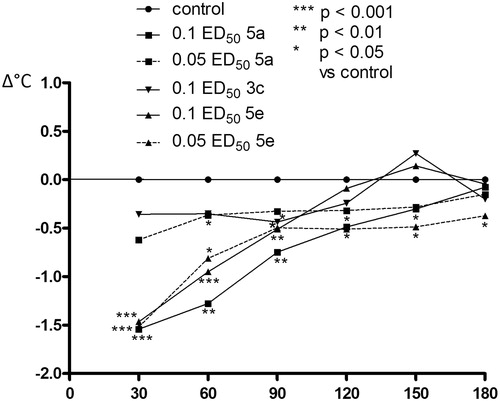
Figure 11. The influence of compound 4c (used at the doses of 0.1 and 0.05 ED50) on the body temperature of mice. Two-way ANOVA revealed significant effects for both doses [F(2,146) = 45.70; p < 0.0001] and time [(F(5,146) = 3.18; p < 0.01], as well as a statically significant dose x time [F(10,146) = 3.02; p < 0.01]. Post-hoc Bonferroni test confirmed a significant decrease in the body temperature of mice after the administration of compound 4c at the dose of 0.1 ED50 from 120 to 150 min (p < 0.01).
![Figure 11. The influence of compound 4c (used at the doses of 0.1 and 0.05 ED50) on the body temperature of mice. Two-way ANOVA revealed significant effects for both doses [F(2,146) = 45.70; p < 0.0001] and time [(F(5,146) = 3.18; p < 0.01], as well as a statically significant dose x time [F(10,146) = 3.02; p < 0.01]. Post-hoc Bonferroni test confirmed a significant decrease in the body temperature of mice after the administration of compound 4c at the dose of 0.1 ED50 from 120 to 150 min (p < 0.01).](/cms/asset/d83d6eda-7b38-42bf-a291-bf4566dbed95/ienz_a_965699_f0011_c.jpg)
Figure 13. The map of the electrostatic potential (ESP) onto a surface of the electron density for 3b – A, 4c – B, 5e – C and 6d – D.
